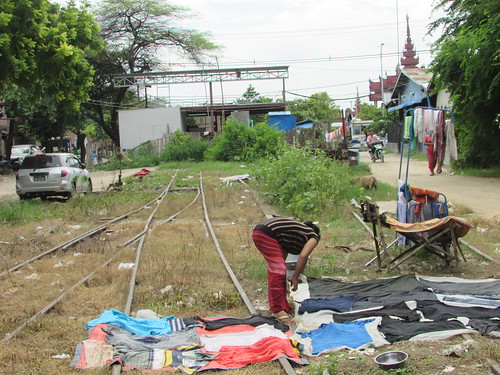So, you may imagine, I was intrigued when I discovered that Mandalay, too, had a Circle Line. It seemed clear enough from the map - leave Mandalay heading south, branch left onto the Lashio line at Myo Haung, branch left again at Thoe Gyan and travel north through the eastern part of the city, turn west then south so as to join the Madaya line at Owe Boe and continue so as to enter Mandalay station from the north.
The line to Madaya had originally been a 2 foot 6 inch gauge light railway (described in the post here) but, after that railway's closure in 1927, the line was rebuilt to metre gauge and connected to the main station at Mandalay. This would involve passing through the grounds of Mandalay Palace and somehow crossing its moat (twice) which troubled me since I'd seen no railway bridges over the moat and the alternative of diving into a tunnel seemed problematic.
To add to my puzzlement, nobody seemed to understand my queries about the times of trains on the Circle Line - maybe there was one a day, I was told, but it was all uncertain.
Myanma Railways publish a map of the lines in Mandalay Division and that, too, seemed to confirm the existence of the Circle Line.

Route Map of Mandalay Division (Myanma Railways).
In 2014, I looked from Mandalay station towards the tracks leading north without solving the riddle.

Mandalay Station, showing the tracks to the north in 2014.
In 2015, I made a more serious attempt to clarify matters. Leaving the station, I walked south on 78th Street, crossed the railway by 34th Street at a frequently-used crossing point for pedestrians involving stepping over the rails, headed north outside the boundary wall of the railway, through an area known, I believe, as Tayoke Tan Market or 79th Street, turned right to walk east on 26th Street (next to the South Palace Moat) for a few yards, before taking an alley to the west of 78th Street where the was no railway boundary wall and I had a good view of the shunting in progress and secured a number of pictures. Here, I found a stop block at the northern limit which suggested that the line northwards no longer existed.

Stop block at the northern limit of the line on alley to west of 78th Street at the north end of Mandalay Station.
It was not until late 2017 that my friend took me to the fascinating open-air market at Tha Ye Ze which takes place on the approach tracks to Tha Ye Ze Station. I described my amazement as a train arrived and ran round its train, temporarily displacing the traders and most of their vegetables, in the post here. To the south of Tha Ye Ze Station, there is a short headshunt allowing the locomotive to run round and then the line stops, just short of 12th Street (next to the North Palace Moat).

Tha Ye Ze (Madaya Line) looking south showing the end of the line. The steel frame of a new building is on 12th Street. Once the locomotive has run round, the track is covered with washing being dried.
On the late 2017 trip, I'd also been told that there was one departure a day from Mandalay to Madaya, at 5.00 a.m. Slowly, realisation dawned - there was, now, no 'Circular Railway'. The 5.00 a.m. train was, almost certainly, the train I'd seen at Tha Ye Ze around 11.00 o'clock. Having left Mandalay heading south, it had branched left onto the Lashio line at Myo Haung, branched left again at Thoe Gyan and travelled north through the eastern part of the city, before turning through 180 degrees so as to join the Madaya line at Owe Boe, finally continuing to the present terminus, Tha Ye Ze. Having run round its train, it could then perform trips to Madaya, as required, before returning to Mandalay by reversing the procedure adopted to first reach Tha Ye Ze in the morning.
But had there ever been a Circle Line? 'Oh yes', said my friend, a long-term resident in Mandalay. South of Tha Ye Ze, there had been a level crossing on 12th Street, a bridge over the Palace Moat then the line pierced the Palace Wall, passed across the Palace grounds, pierced the walls again, crossed the Moat on another bridge and 26th Street on a level crossing before entering the north end of Mandalay station. as I'd anticipated. But Mandalay Palace grounds are a Military area so, some time in the 1990s, the line through the Palace grounds was severed, to improve security.
We drove along 12th Street, so that I could photograph the part of the Palace Walls which the railway passed through and, indeed alterations to the brickwork are apparent.

View of Palace Wall to the south of 12th Street. Note the alterations to the brickwork on the right of the picture.
I was pleased that I had 'solved the riddle'. However, only a few days later, I discovered that a far more detailed account of this history will appear in my friend Dieter Hettler's eagerly-awaited book "Railways of Myanmar"!
Related posts on this website
The Madaya Light Railway.
Mandalay Area Railways.
Alternately, clicking on the 'All my Myanma Railways Posts' displays all my posts describing railways in Myanmar in reverse date-of-posting order.
All my Myanma Railways Posts.
My photograph albums
Where necessary, clicking on an image above will display an 'uncropped' view or, alternately, pictures may be selected, viewed or downloaded, in various sizes, from the albums listed:-
Mandalay's railways.
Mandalay's railways, 2015.
Owe Boe Station, Mandalay.
MR: Tha Ye Ze.
Myo Haung Station, 2013.
MR: Myo Haung Signal Cabin.
